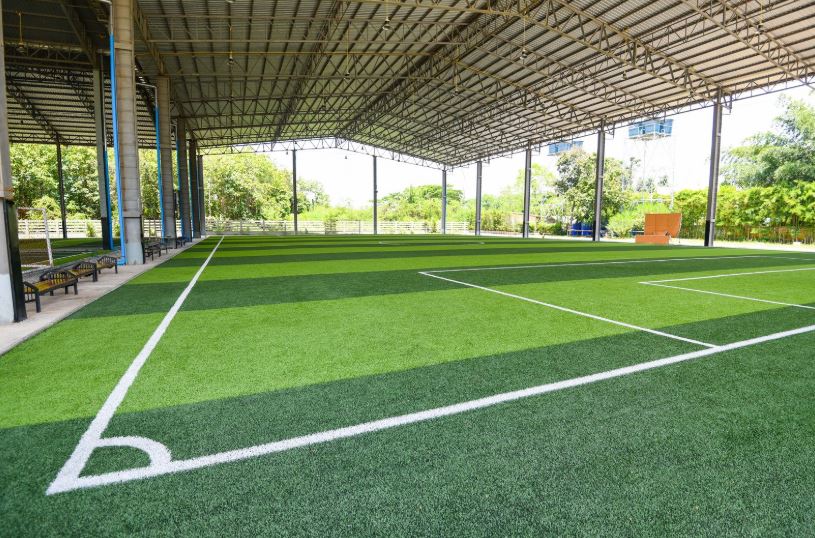Futsal Court Installation: A Comprehensive Guide
Futsal, the fast-paced, indoor version of soccer, has exploded in popularity across the U.S., captivating players of all ages and skill levels. Its emphasis on quick footwork, precision passing, and tactical play makes it an excellent sport for developing core soccer skills and enjoying a dynamic game.
For facilities, schools, recreational centers, and even private residences looking to capitalize on this growing trend, understanding the intricacies of futsal court installation is paramount. This guide delves into the key considerations, from initial design to final surfacing, ensuring your futsal court provides a safe, durable, and high-performance playing experience.

The Foundation of Play: Subsurface Preparation
The success and longevity of any futsal court hinge on a properly prepared subsurface. Whether you're converting an existing space or building from the ground up, the base needs to be stable, level, and well-drained.
Indoor Futsal Court Subsurfaces
For indoor futsal courts, the most common and recommended subsurfaces are concrete or asphalt. These materials provide a solid, consistent foundation for the chosen court surfacing.
- Concrete: a concrete slab offers exceptional stability and can be poured to precise specifications, ensuring a perfectly level playing surface. Proper curing and expansion joints are crucial to prevent cracking and ensure durability.
- Asphalt: asphalt can also serve as a suitable subsurface, particularly for larger indoor spaces. It's generally more flexible than concrete, which can be advantageous in some scenarios, but requires careful attention to compaction and drainage to prevent issues like unevenness or water pooling.
Outdoor Futsal Court Subsurfaces
While this guide focuses primarily on indoor installations, it's worth noting that outdoor futsal courts also require meticulous subsurface preparation. A compacted aggregate base, followed by an asphalt or concrete layer, is typical. Proper grading and drainage systems are even more critical outdoors to manage rainwater effectively and prevent surface damage or ponding.
Contact our team to request a tailored quote or receive technical specifications for your next futsal indoor project.
Choosing the right futsal court flooring
The flooring material is perhaps the most critical decision in futsal court installation, directly impacting player safety, performance, and court durability.
Artificial turf for futsal courts
While not a traditional futsal surface, artificial turf is sometimes considered, especially for outdoor futsal courts or multi-sport indoor facilities where a more "natural" feel is desired. However, it's crucial to understand the nuances of using artificial turf for futsal.
- Pile height and infill: for futsal, if artificial turf is used, it must have a very short pile height and a minimal or absent infil, such as our Zerofill, a surface that doesn’t require any stabilisation or performance infill.
- Ball response: even with a short pile, artificial turf will never provide the same true ball roll and consistent bounce as a hard, smooth surface like modular tiles or vinyl. But in case you desire a natural filing, turf is the only solution and you can try our exceptional Double X with resilience and an extraordinary elastic memory.
- Player traction and sliding: artificial turf offers excellent traction, which can be beneficial, as Italgreen’s Lesmo 3 S, a three color and three shape futsal turf.
- Maintenance: while artificial turf requires less maintenance than natural grass, it still needs regular brushing to maintain infill levels and prevent matting.
- Durability for futsal: artificial turf designed for soccer can withstand heavy foot traffic. For futsal, the constant quick turns and pivots might put different stresses on the fibers, so choosing a durable, high-quality turf specifically engineered for multi-sport use (if applicable) is important.
- Aesthetics and versatility: artificial turf can provide a vibrant, green aesthetic year-round without the need for watering or mowing. For facilities that host various sports, a short-pile artificial turf might offer a compromise, allowing for futsal play while also accommodating other activities that benefit from a softer, grass-like surface.
Designing your futsal court: dimensions and markings
Once the subsurface and flooring material are decided, the next step is to design the court itself. Futsal court dimensions vary, but generally adhere to a 2-to-1 length-to-width ratio.
- Standard Dimensions: Common court sizes range from 80' x 40' to 100' x 50'. Some professional courts can reach up to 140' x 70'.
- Line markings: crucial for fair play and game flow, accurate line markings are essential. These include:
- Touchlines and goal lines: defining the boundaries of the playing area.
- Halfway line: dividing the court into two equal halves.
- Center mark and circle: for kick-offs.
- Penalty area (d-zone): the semi-circular area in front of each goal.
- Penalty mark (6-meter mark): for penalty kicks.
- Second penalty mark (10-meter mark): for direct free kicks from the second penalty spot.
- Corner arcs: for corner kicks.
- Substitution zones: located on the touchline in front of the team benches.
These lines can be painted directly onto the court surface (for artificial turf, this would involve specialized paint or inlaid lines). Precision in these markings is vital for official play.
Additional features and amenities
To create a truly exceptional futsal facility, consider incorporating additional features and amenities:
- Goals: regulation-size futsal goals are smaller than traditional soccer goals, typically measuring 3 meters wide by 2 meters high. They should be securely anchored to prevent tipping.
- Rebound walls/dashing boards: these perimeter systems prevent the ball from going out of play, keeping the action continuous and enhancing player development. They are particularly popular in mini-pitches and provide a dynamic, fast-paced game.
- Lighting: adequate lighting is crucial for both player visibility and safety, especially for indoor courts or evening play outdoors.
- Fencing/netting: to contain errant shots and protect spectators, fencing or netting around the court perimeter is often a smart investment.
- Seating: providing comfortable seating for spectators and players enhances the overall experience.
- Scoreboards: for competitive play, a scoreboard adds to the professional atmosphere.
- Team Benches: designated areas for players to rest and strategize.
Why invest in a futsal court?
The appeal of futsal extends beyond just being a fun game. Its compact court size allows for multiple games in a smaller footprint compared to traditional soccer fields, making it ideal for urban areas or facilities with limited space. This efficiency also translates to lower construction and maintenance costs. Furthermore, futsal’s indoor nature means play isn't dictated by weather, guaranteeing year-round use and revenue potential for commercial facilities. For players, the smaller court forces constant engagement, improving ball control, decision-making under pressure, and overall fitness.
Contact our team to request a tailored quote or receive technical specifications for your next futsal indoor project.
- Via Crusnigo, 11
- 24030 Villa d'Adda (Bergamo)
- VAT number: IT01640880165
- Cod. Fiscale 07075130158
- Cod. Destinatario SUBM70N
- Shared capital: € 5,000,000
- REA BG 214799
- Phone number: +39 (035) 784-178
- Fax: +39 (035) 784-144
- Email: contact@italgreen.it
- PEC: italgreen@mailcertificata.org
- CLICK HERE to Whistleblowing

- Padel
- Artificial lawn
- Padel courts: benefits, construction and installation
- Build a tennis court: the complete guide by Italgreen
- Artificial grass manufacturers and suppliers
- Synthetic grass tennis court: benefits and supply
- Padel
- Artificial grass for sports
- Artificial grass manufacturers
- Sports artificial grass
- Synthetic grass manufacturer
- Italgreen: golf turf manufacturers and suppliers since 1983
- NEW LIMITED EDITION PADEL COURTS
- Padel court manufacturers: why choose Italgreen
- Sports turf manufacturers since 1983
- Indoor padel courts
- Italgreen’s synthetic soccer field
- The steps to replace the synthetic grass for padel
- Hybrid Turf
- High-quality artificial sports turf manufacturer
- Padel court supplier
- Artificial grass factory: Italgreen is at your disposal
- Soccer turf installation: a guide by Italgreen
- Padel court maintenance
- Synthetic Turf Suppliers
- Padel court builder: Italgreen is the solution
- Comprehensive guide to synthetic soccer turf: benefits, installation, and maintenance
- Field hockey turfs: a comprehensive guide
- Padel Court Design, Project, and Installation
- Artificial football turf